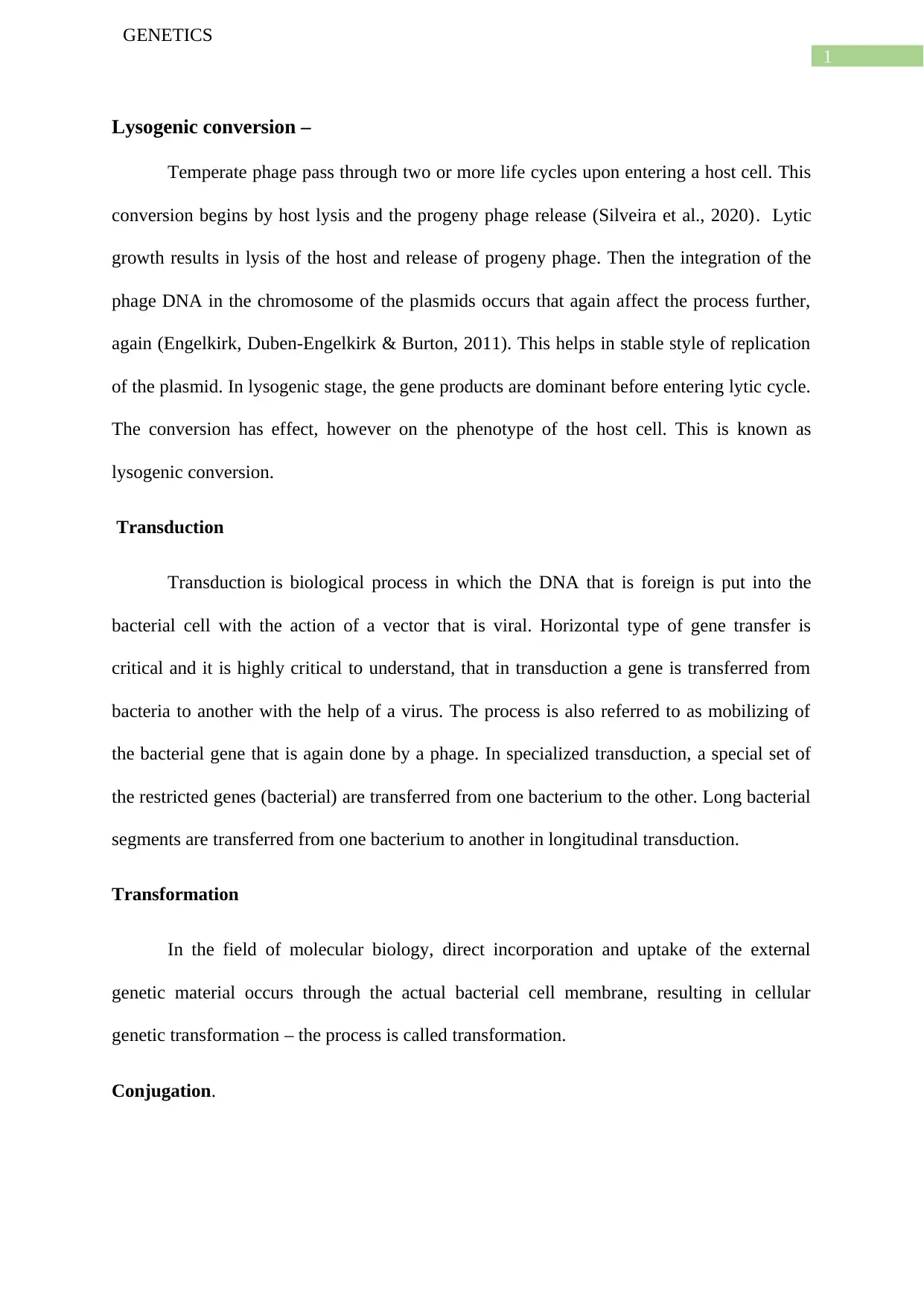Genetics - Lysogenic Conversion
VerifiedAdded on 2022/08/13
|4
|432
|23
AI Summary
Contribute Materials
Your contribution can guide someone’s learning journey. Share your
documents today.

Running head: GENETICS
GENETICS
Name of Student
Name of University
Author note
GENETICS
Name of Student
Name of University
Author note
Secure Best Marks with AI Grader
Need help grading? Try our AI Grader for instant feedback on your assignments.

1
GENETICS
Lysogenic conversion –
Temperate phage pass through two or more life cycles upon entering a host cell. This
conversion begins by host lysis and the progeny phage release (Silveira et al., 2020). Lytic
growth results in lysis of the host and release of progeny phage. Then the integration of the
phage DNA in the chromosome of the plasmids occurs that again affect the process further,
again (Engelkirk, Duben-Engelkirk & Burton, 2011). This helps in stable style of replication
of the plasmid. In lysogenic stage, the gene products are dominant before entering lytic cycle.
The conversion has effect, however on the phenotype of the host cell. This is known as
lysogenic conversion.
Transduction
Transduction is biological process in which the DNA that is foreign is put into the
bacterial cell with the action of a vector that is viral. Horizontal type of gene transfer is
critical and it is highly critical to understand, that in transduction a gene is transferred from
bacteria to another with the help of a virus. The process is also referred to as mobilizing of
the bacterial gene that is again done by a phage. In specialized transduction, a special set of
the restricted genes (bacterial) are transferred from one bacterium to the other. Long bacterial
segments are transferred from one bacterium to another in longitudinal transduction.
Transformation
In the field of molecular biology, direct incorporation and uptake of the external
genetic material occurs through the actual bacterial cell membrane, resulting in cellular
genetic transformation – the process is called transformation.
Conjugation.
GENETICS
Lysogenic conversion –
Temperate phage pass through two or more life cycles upon entering a host cell. This
conversion begins by host lysis and the progeny phage release (Silveira et al., 2020). Lytic
growth results in lysis of the host and release of progeny phage. Then the integration of the
phage DNA in the chromosome of the plasmids occurs that again affect the process further,
again (Engelkirk, Duben-Engelkirk & Burton, 2011). This helps in stable style of replication
of the plasmid. In lysogenic stage, the gene products are dominant before entering lytic cycle.
The conversion has effect, however on the phenotype of the host cell. This is known as
lysogenic conversion.
Transduction
Transduction is biological process in which the DNA that is foreign is put into the
bacterial cell with the action of a vector that is viral. Horizontal type of gene transfer is
critical and it is highly critical to understand, that in transduction a gene is transferred from
bacteria to another with the help of a virus. The process is also referred to as mobilizing of
the bacterial gene that is again done by a phage. In specialized transduction, a special set of
the restricted genes (bacterial) are transferred from one bacterium to the other. Long bacterial
segments are transferred from one bacterium to another in longitudinal transduction.
Transformation
In the field of molecular biology, direct incorporation and uptake of the external
genetic material occurs through the actual bacterial cell membrane, resulting in cellular
genetic transformation – the process is called transformation.
Conjugation.

2
GENETICS
In molecular biology, conjugation is a process in which the genetic material is
transferred from one bacterium to another bacterium by direct contact. There is a donor and a
recipient bacterium.
GENETICS
In molecular biology, conjugation is a process in which the genetic material is
transferred from one bacterium to another bacterium by direct contact. There is a donor and a
recipient bacterium.

3
GENETICS
References
Engelkirk, P. G., Duben-Engelkirk, J. L., & Burton, G. R. W. (2011). Burton's microbiology
for the health sciences. Lippincott Williams & Wilkins.
Silveira, C. B., Coutinho, F. H., Cavalcanti, G. S., Benler, S., Doane, M. P., Dinsdale, E.
A., ... & Rohwer, F. L. (2020). Genomic and ecological attributes of marine
bacteriophages encoding bacterial virulence genes. BMC Genomics, 21(1), 1-11.
GENETICS
References
Engelkirk, P. G., Duben-Engelkirk, J. L., & Burton, G. R. W. (2011). Burton's microbiology
for the health sciences. Lippincott Williams & Wilkins.
Silveira, C. B., Coutinho, F. H., Cavalcanti, G. S., Benler, S., Doane, M. P., Dinsdale, E.
A., ... & Rohwer, F. L. (2020). Genomic and ecological attributes of marine
bacteriophages encoding bacterial virulence genes. BMC Genomics, 21(1), 1-11.
1 out of 4
Your All-in-One AI-Powered Toolkit for Academic Success.
+13062052269
info@desklib.com
Available 24*7 on WhatsApp / Email
![[object Object]](/_next/static/media/star-bottom.7253800d.svg)
Unlock your academic potential
© 2024 | Zucol Services PVT LTD | All rights reserved.